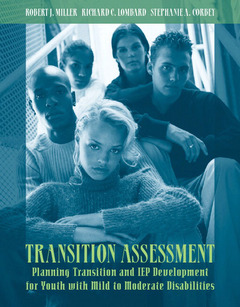Description
Transition Assessment
Planning Transition and IEP Development for Youth with Mild to Moderate Disabilities
Authors: Miller Robert, Lombard Richard, Corbey Stephanie
Language: English
Subject for Transition Assessment:
66.23 €
Subject to availability at the publisher.
Add to cart320 p. · 21.6x27.4 cm · Paperback
Description
/li>Contents
/li>Comment
/li>
A practical, ?hands on? book designed to provide the reader with a comprehensive understanding of how to use assessment information to develop transition plans.
Extremely practical and comprehensive, this new text demonstrates how to use transition assessment information to plan and design IEP goals and objectives. Theory, practice and application are tied together to develop the readers knowledge and skill in transition assessment. As such, the reader is provided with what to assess as well as how to assess. Finally, the book is structured to allow the reader to practice and demonstrate their understanding of transition assessment.
The text provides students with a model of transition assessment and several criterion referenced assessment instruments useful in student assessment. Plus, a chapter dedicated to each component of a holistic transition assessment model that helps students practice what and how to assess.
I. THE FOUNDATION OF TRANSITION ASSESSMENT.
1. Transition Planning and Transition Assessment: What Is It? Why Do We Do It?
Historical Overview.
IDEA and Transition Planning.
Transition Assessment.
Relationship of the Transition Plan to Other IEP Goals and Objectives.
2. Career Development and Transition Assessment.
Career Maturity.
Career Development and Disability.
Career Development and Transition Assessment.
“Readiness” to Make Career Decisions.
3. Assessment of Future Planning Needs.
The Relationship of Career Planning, Future Planning, and Transition Assessment.
Resources for Assessing Future Planning Needs of Students with Mild to Moderate Disabilities.
Future Planning Inventory System.
Using Future Planning Assessment Information to Develop IEP Goals.
Resources for Assessing Future Planning Needs of Students with Mild Disabilities.
Resources for Assessing Future Planning Needs of Students with Moderate to Severe Disabilities.
4. Assessment of Self-Determination and Self-Advocacy Skills.
The Relationship between Self-Determination and Self-Advocacy.
Resources for Assessing Self-Determination.
Commercially Available Self-Determination Assessments.
Additional Resources for Self-Determination, Self-Advocacy, and Future Planning.
II. BUILDING BLOCKS FOR EFFECTIVE TRANSITION ASSESSMENT AND PLANNING.
5. Using Academic and Behavioral Assessment Information for Transition Planning.
Learning Style Assessment.
6. Functional Life Skills Assessments.
Social Skills.
Social Competence.
Comprehensive Transition Assessments.
Life-Centered Career Education Assessment Instruments.
Transition Planning Inventory (TPI).
Life-Skills Assessments.
Use of the Future Planning System (FPS) to Gather Life-Skills Assessment Information.
Summary of Future Planning System for Tenisha.
7. Vocational Assessment.
Vocational Assessment Assumptions.
Step One: Identifying Essential Information That Must Be Collected Prior to Vocational Program Entry.
Step Two: Develop Data Collection and Exchange Procedures for the Entry Phase.
Step Three: Use Assessment Information to Plan the Student’s Vocational Education Program.
Step Four: Identify Essential Information That Must Be Collected to Monitor Each Student’s Progress in the Vocational/Community Education Program.
Step Five: Develop Data Collection and Data Exchange Procedures for Information That Is Monitored in School and Community Settings.
Step Six: Identify Essential Information That Must Be Reviewed Prior to the Student’s Transition into Future Planning or Employment Settings.
Step Seven: Conduct an Exit Transition Meeting.
8. The MAGIC Model: How to Integrate Formal and Curriculum Based Assessment for Career Planning.
Component One: Make a Prediction about Future Settings.
Component Two: Assess Entry-Level Skills of Predicted Settings.
Component Three: Guide Student’s Acquisition of Discrepant Skills.
Component Four: Instruct for Generalization.
Component Five: Conduct Maintenance Checks.
9. Using Transition Assessment Information to Design an Effective Transition Plan.
Joe Site: Longitudinal Transition Planning.
Summary of Transition Assessment Information from 9th Grade Evaluation.
Summary of Transition Assessment Information from 10th Grade Evaluation.
Transition Planning for the Senior Year.
Summary of Transition Assessment Information from 11th Grade Evaluation.
Summary of Joe Site’s Transition Plan.
10. The Collaborative Transition Model: An Interdisciplinary Approach to District-Wide Transition Planning.
The Collaborative Transition Model.
Step One: Internal Steering Committee.
Step Two: Transition Core Team.
Step Three: Community Survey.
Step Four: Community Action Plan.
Step Five: Individualized Transition Process.
Step Six: Annual Evaluation.
Appendix A: Informal Transition Assessment Instruments.
A-1. Questions to Ask to Gauge Career Maturity of Students.
A-2. Future Planning Inventory.
Form 1: Student Inventory.
Form 2: Parent Inventory.
Form 3: Educator Inventory.
A-3. Self-Determination and Self-Advocacy Skills Questionnaire.
Form 1: Student Form
Form 2: Parent Form
Form 3: Educator Form
Form 4: Student and Teacher Interview: Performance Battery
Form 5: Scoring Summary Sheet
A-4. C.I.T.E. Learning Styles Inventory
A-5. Transition Exit Form: Interagency Responsibilities
A-6. Student Centered Data / Student Interview Format
A-7. Program Inventory Form
A-8. Vocational Assessment Profile
Appendix B: Completed Informal Assessment Information for Activities
B-1. IDEA 1997–Critical Part 300 Regulations Regarding Transition Planning.
B-2. Completed Activity Forms–Future Planning Inventories for Susan McMillin.
Form 1: Student Inventory.
Form 2: Parent Inventory.
Form 3: Educatory Inventory.
B-3. Completed Activity Forms–Self-Determination and Self-Advocacy Test Results for Sara P.
Form 1: Student Questionnaire
Form 2: Parent Questionnaire
Form 3A: Educator Questionnaire, Part A
Form 3B: Educator Questionnaire, Part B
B-4. Activity Forms–C.I.T.E. Learning Styles Results for Sara Jones.
B-5. Activity Summary–Transition Planning Inventory (TPI) Results for Juan Rodrigiez
B-6. Activity Summary–Transition Exit Form: Interagency Responsibilities for Heidi Camper.
B-7. Activity Forms
Form 1: Vocational Assessment Profile Results for Spencer McGillacutty
Form 2: Program Inventory Results for Spenser McGillacutty
Form 3: Learning and Working Learning Style Results for Spencer McGillacutty
Appendix C: Transition Assessment Documents.
C-1. Transition Assessment Tools —Sequence of Assessment Tools Used by Large District over Junior High and High School.
C-2. Transition Planning Checklist.
C-3. Individual Student Transition Portfolio.
C-4. Interagency Guide for Transition Planning.
C-5. Post High School Follow-Up Survey: Class of 2001.
Appendix D: Reevaluation Report: Joe Site–9 th grade.
Appendix E: Selected Assessment Tools for Transition Planning for Students with Mild Disabilities.

